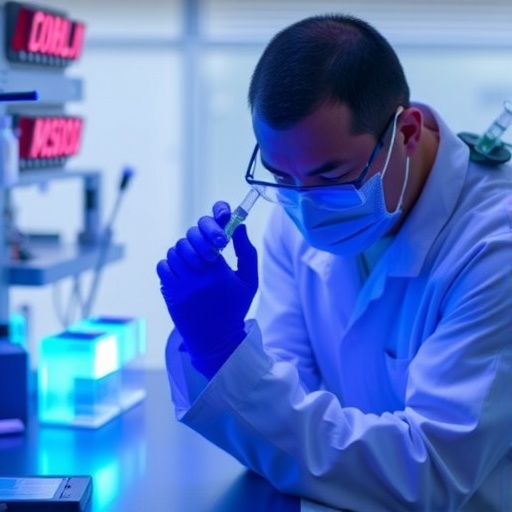Tumor immunotherapy has revolutionized the landscape of cancer treatment by harnessing the power of the immune system, particularly T cells, to detect and eradicate malignant cells. Despite significant strides in this field, one of the enduring challenges remains the insufficient presence of tumor-associated antigens on the surface of cancer cells. These antigens, often expressed at low densities, struggle to effectively activate T cells, resulting in suboptimal immune responses. Complicating this issue further, the low-level expression of these antigens on normal tissues raises concerns of off-target effects and toxicity, undermining treatment safety and specificity.
Addressing this critical bottleneck, a pioneering study recently published in Nature by Professor HAN Shuo’s team at the Center for Excellence in Molecular Cell Science, Shanghai Institute of Biochemistry and Cell Biology, Chinese Academy of Sciences, introduces a groundbreaking cell-surface protein engineering technique named Proximity Amplification and Tagging of Cytotoxic Haptens (PATCH). This innovative strategy for the first time applies proximity labeling—traditionally a biochemical tool for mapping protein-protein interactions—as a means to directly modulate the tumor cell surface, enhancing immune recognition and response.
Proximity labeling has long been a stalwart in chemical biology for elucidating spatial relationships between proteins in complex cellular milieus. The paradigm shift in this study lies in the ingenious repurposing of this technology from a detection method into a signal amplification tool with therapeutic potential. By selectively increasing the density of artificial antigens on tumor cells, the PATCH method empowers the immune system’s T cells to discern and attack malignant cells with unprecedented precision and potency.
The heart of the PATCH approach is the employment of an engineered nanozyme known as PCN, which is externally administered and accumulates on the tumor cell surface. This nanozyme remains inert until triggered non-invasively by external stimuli such as red light or ultrasound, allowing for spatial and temporal control over its activation. Upon stimulation, PCN catalyzes the rapid formation of covalent bonds between numerous probe molecules bearing artificial antigen tags—specifically fluorescein isothiocyanate (FITC)—and proteins within immediate proximity on the tumor cell membrane. This localized chemical reaction results in a dense cluster of antigenic epitopes that mimic natural targets recognizable by immune effector cells.
Importantly, these engineered high-density antigen clusters function as artificial “super-beacons,” dramatically enhancing the visibility of cancer cells to the immune system. When combined with bispecific T-cell engagers (BiTEs)—molecules engineered to simultaneously bind FITC and the CD3 receptor on T cells—the modified tumor surface efficiently recruits and clusters T-cell receptors (TCRs). This orchestrated receptor aggregation triggers robust T-cell activation, significantly improving the immune-mediated cytotoxic response against tumor cells.
The therapeutic efficacy of PATCH has been impressively demonstrated across diverse solid tumor animal models as well as in clinically derived human tumor samples. The method has shown the ability to completely eradicate treated tumors, an achievement rarely observed with conventional immunotherapies. Even more compelling is the induction of a systemic immune response following localized treatment, characterized by the release of endogenous tumor antigens that prime immune cells to recognize and attack distant, untreated tumors in an abscopal effect. This systemic engagement not only amplifies tumor clearance but also fosters the development of durable immunological memory, offering protection against tumor recurrence.
This study signifies a landmark advancement by expanding the utility of proximity labeling beyond its traditional analytical framework into a potent immunotherapeutic modality. The PATCH strategy effectively circumvents the obstacle of insufficient antigen density, a fundamental limitation in cancer immunotherapy, while maintaining exceptional treatment specificity via localized nanozyme activation. This balance minimizes collateral damage to healthy tissues, a critical parameter for clinical translation.
Beyond its immediate therapeutic implications, the PATCH strategy sets a new precedent in the design of immunomodulatory technologies. By harnessing the precision and controllability inherent to chemical proximity labeling reactions, it opens avenues for engineering cell surfaces with bespoke antigenic landscapes tailored for customized immune targeting. This platform could be adapted or expanded to other types of immune cells or diseases where enhancing cell-cell recognition is therapeutically advantageous.
Moreover, the noninvasive activation modalities—red light and ultrasound—integrated into PATCH provide a versatile and patient-friendly means for spatiotemporal control in vivo, circumventing the toxicity and off-target activation risks often associated with systemic treatments. This precise activation enhances the therapeutic window and potentially allows combination with other modalities for synergistic cancer therapy.
In summary, the research conducted by Professor HAN Shuo and colleagues presents a novel conceptual and practical framework that revolutionizes the interface between chemical biology and immunotherapy. PATCH’s ability to amplify tumor antigen signals on demand empowers T cells to overcome previous immunological blind spots, yielding a highly effective and specific cancer treatment modality. The successful demonstration of this technology in preclinical models lays robust groundwork for future clinical studies and the development of next-generation immunotherapies that are both potent and safe.
As tumor immunotherapy continues to evolve, the integration of proximity labeling as a functional cell-surface engineering tool embodies the kind of interdisciplinary innovation crucial for addressing complex challenges in oncology. PATCH exemplifies how rethinking and repurposing existing technologies can unlock transformative therapeutic potentials, bringing us closer to curative treatments for multiple cancer types.
With its promise of amplifying antigen-induced cellular responses to new heights, the PATCH strategy is poised to become a pivotal advancement in the global fight against cancer, promising enhanced patient outcomes through precision and power in immune activation.
Subject of Research: Tumor immunotherapy; proximity labeling; cell-surface protein engineering; immune modulation.
Article Title: Amplifying antigen-induced cellular responses with proximity labelling
News Publication Date: 10-Sep-2025
Web References:
https://doi.org/10.1038/s41586-025-09518-6
Keywords: Cancer immunotherapy, proximity labeling, nanozyme, T-cell activation, bispecific T-cell engager, tumor antigen amplification, immunotherapy specificity, molecular cell engineering.




